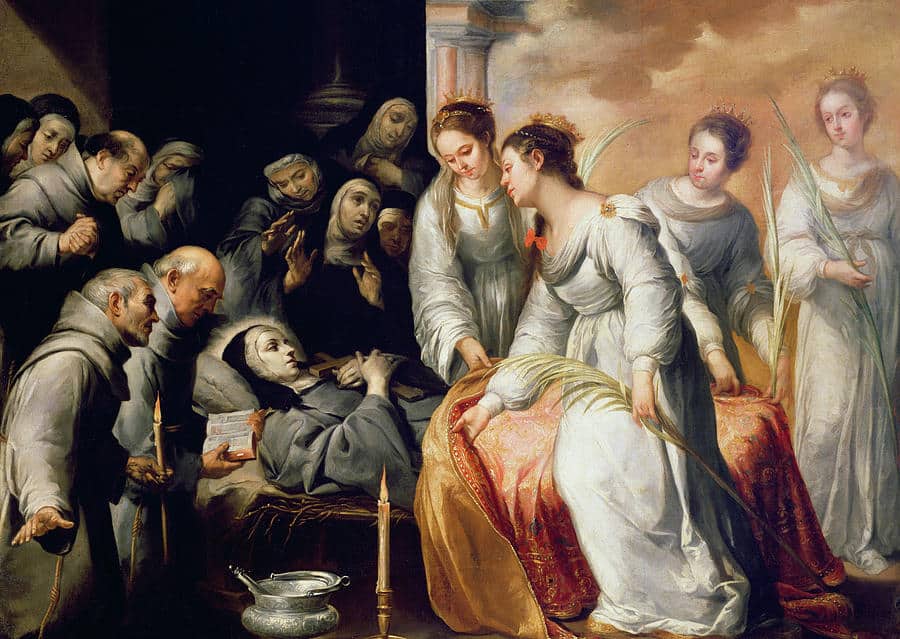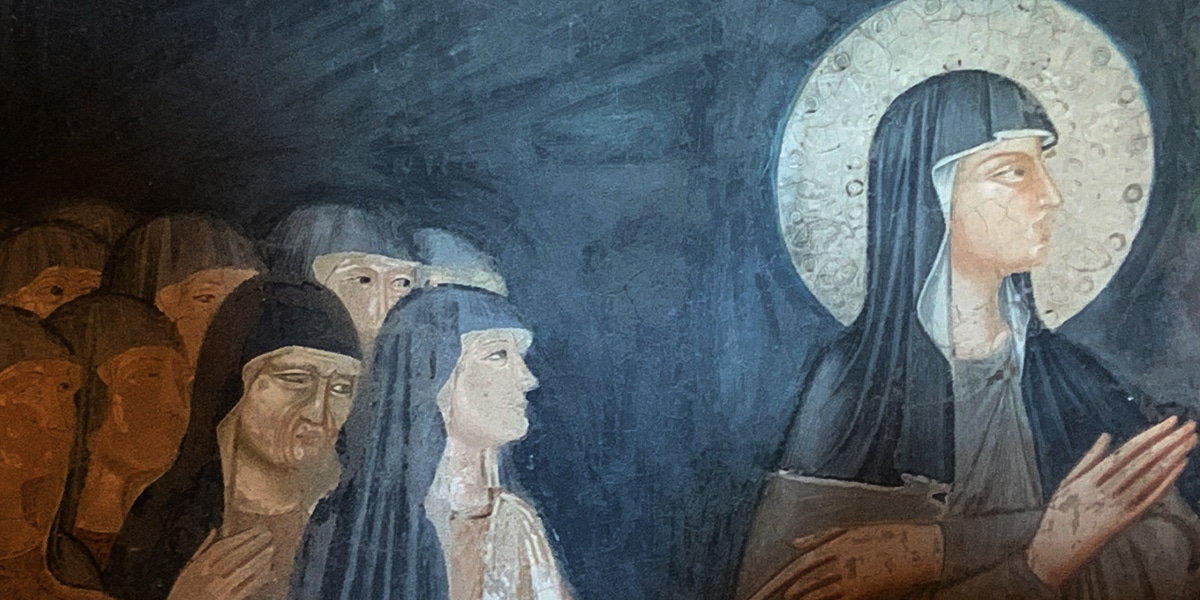When this beloved saint died, the Church lost a luminary. But her legacy shines brightly to this day.
In 1253, Clare’s health began to deteriorate. With August’s scorching temperatures, she was closer and closer to the end. As always, the late summer heat drove the papal entourage from Rome to the refreshing heights of Perugia. It would not be long until these dignitaries heard the news echoing from hill to hill in the Valley of Spoleto: Madonna Chiara was dying.
Pope Innocent IV understood the meaning of the moment. His nephew, Cardinal Rainaldo, accompanied him on the journey to the little cloister. This pope, whose attempt at a Rule for the women had been politely rejected by San Damiano’s sisters, arrived to see its famous abbess. She received him with utter respect and humble gratitude.
How wonderful was this? The successor of St. Peter was under her roof! He asked the crucial question: What was her deathbed wish? She was ready with her answer. Would he place his signature and seal on her Rule? No question would ever be raised about its force and power if he were to comply with this one wish. Her plea was uttered with all the force of a soul bent on completing its earthly mission.
What followed was a touching 24-hour drama. Cardinal Rainaldo gave his approval by signing the actual parchment upon which the text was inscribed. Normal protocol would have required that a new manuscript be prepared in the pope’s secretariat. However, it was clear that there was not enough time if the pope was to grant her wish before her final hour. His choice was to expedite the legal process.
Using the manuscript already signed by Cardinal Rainaldo, he added his own signature and date. To this was added his impressive seal. As he ordered it to be sent back to Assisi, he may have reflected that it would serve one monastery and one monastery only. No great harm done, therefore, in acceding to the dying wish of a respected abbess. Besides, it was a work of mercy that might win heavenly favor for him in an hour of need. Assisi’s newest saint would surely intercede for him after death.
A friar-messenger was dispatched to bring it back to Assisi with all possible speed. When the document was placed in her hands, Clare took hold of the beautiful papal seal, affixed with golden cords and hanging from the scroll. Later, an eyewitness would write on that parchment, “Blessed Clare touched and kissed this many times out of devotion.”
This elation expressed her utter relief and joy. She had succeeded in creating a perpetual witness to the first inspirations of the Poor Sisters and their covenant with Francis and his Lesser Brothers. Like her Divine Master, she could now say, “It is finished.”
Visions of the Vigil
The extraordinary papal about-face that took place in those August days was not the only miraculous event witnessed by the women keeping vigil with Clare in her final days. Those who were present would later recall other dramatic signs that they sealed in memory.
A nun in the Monastery of San Paolo shared an exceptional vision. In it she and her sisters were at the side of Clare, who lay in a beautiful bed. They grieved with the distraught sisters keeping vigil. Then a woman of great beauty appeared at the head of the bed and assured the sisters that Clare’s victory was assured and that she would not die without seeing “the Lord and his disciples.” The fact that nuns of San Paolo had such vivid experiences of Clare’s final days hints at a relationship that had blossomed over the years since her Eastertide sojourn in 1212.
Sister Benvenuta of Lady Diambra and Sister Anastasia heard Clare speaking softly at one point but to no one in particular. Worried that Clare was trying to express a need or discomfort, they asked to whom she was speaking. The answer was, “I am speaking to my soul.” Later, the words they heard were recorded. Clare was, in fact, expressing the kind of hope that replaces fear with her trust in God to escort her over death’s threshold as a mother guides a frightened child. Sister Filippa reported that Clare made a final confession and she marveled at what was told by the dying saint.
Three days before Clare’s passing, Sister Benvenuta began to imagine the way Clare would be received in heaven at the point of death. The imagining morphed into a visionary experience in which she saw a group of women—dressed in white and wearing crowns—surround the bed. In the middle was one woman whose crown was larger and more ornate. The description implies that it was Mary, queen of heaven. The women brought a delicate, transparent coverlet to spread over Clare, a gesture reminiscent of women preparing a bridal bed.
In the dormitory of San Damiano is a bronze bas-relief on the wall of the room where Clare died. It shows friars who are clearly bereft kneeling at her side. Her biographer tells us that Brother Angelo was mourning and supporting the grieving sisters while Brother Leo “kissed the bed of the dying woman.” The placement of the sculpture is a reminder of the strength of that promise of care and solicitude that Francis made to Clare.
His oldest friends carried that promise with them as they shared the transitus of their sister. Did they, in the long hours, recall the time when Francis himself set about repairing the crumbling structure of the place? It was his first project as a newly recognized penitent, and he was offering his physical labor to the local priest.
One day, hoping to recruit helpers, he climbed a wall and called out to passersby. He declared that this rundown hospice would someday house holy women who would give glory to God. What was he thinking that day? Who could have imagined what had transpired in the hundreds of days since?
So it was that Clare breathed her last in the house of San Damiano on August 11, 1253. At her side were the women, seen and unseen, with whom she had established the Poor Sisters’ way of life and the men whose loyal friendship was precious evidence of the mutuality that bound them. Clare would now belong not only to these brave founding men and women but to all future generations of Francis’ followers.
From Sister to Saint
Once news of Clare’s death was reported in the city, the people gathered at the monastery expressing grief and wonder. Now their city boasted a second saint whose life would be that “light to the world.”
The funeral conducted in the city was a marvel. Since the whole papal entourage was nearby, its members accompanied Innocent IV to celebrate the funeral Mass. The pope startled his entourage by a proposal that the Mass of Holy Virgins be celebrated instead of a requiem Mass. That choice would, in effect, be a canonization, an affirmation that Clare was officially recognized as a saint.
The members of his court argued restraint. Was it wise to ignore the protocols so recently ratified to ensure the validity of canonization? Won over by these arguments, Pope Innocent offered the traditional Mass for the dead with its supplications and lamentations. However, his readiness to raise Clare to official status as a saint was on full display.
It was that argument that led to the investigation whose record is such an important source for our knowledge of her. She was buried in San Giorgio in the same crypt that had housed the remains of Francis until a tomb in his basilica was ready.
Unwilling to be separated from her even by death, four sisters relocated to the small cloister of San Giacomo de Muro Rupto to be able to keep prayerful vigils at her tomb.
Thus began the transition that would take Clare from the center of a living sisterhood to the center of a cult bringing multitudes to pray in her sanctuary. In only two months’ time, Pope Innocent directed the bishop of Spoleto to open the process for her canonization.

In November, Bishop Bartholomew arrived in Assisi to do his work. Over four days, he and his staff interviewed 15 of the sisters and five citizens of Assisi. Pope Innocent IV died the following month and was succeeded by none other than Cardinal Rainaldo, who took the name Alexander IV. To him would fall the happy task of “raising Clare to the altar,” which he did in 1255.
The Papal Decree of Canonization was a tour de force of verbal diplomacy. Poetic riffs on her name abound with synonyms for light. There are exclamations of astonishment at her miracles and a liberal use of wonderful metaphors: “a spring of water in the Valley of Spoleto,” “a candelabra of sanctity,” a “garden of humility.”
At the same time, the proclamation praises her fidelity to the hierarchical version of women’s religious life and downplays the originality of her Franciscan loyalties. Thus, even in declaring her a saint, Alexander signaled the kind of obedience to be expected of future followers.
Five years later, a new basilica in her honor was ready, and her remains were interred there. The old San Giorgio Church, once the place of Francis’ early education and the temporary crypt for both saints, was incorporated into the new structure. The sisters, now led by a new abbess, departed the San Damiano Monastery and took up residence in the large cloister attached to the basilica. It would be known as the Proto-Monastery—the first of the monasteries of Poor Clares in the world.
Our Common Humanity
As with St. Francis, the crypt of her burial was lodged deep in the lower recesses of the church, far from the nave where pilgrims would venerate the high altar that surmounted the hidden tomb. In the late 19th century, a project to exhume her remains and excavate the crypt was approved. This modern innovation was taking place in each basilica. It was a way to afford pilgrims more direct proximity to the remains. For centuries, medieval fears of kidnappings of a sarcophagus had kept the actual tomb secret and remote. Now the pilgrim would be able to approach the resting place at arm’s length.
Today, the visitor to Clare’s basilica will see a sculpture that represents her body, behind which is a vessel with her actual remains. Carefully renovated for her 1993 centenary, the image represents the body, which would have been placed there in 1261 and which was glimpsed fleetingly by those present at the exhumation.
Nearby is a museum display that holds memorabilia of importance including her habit, the alb long thought to have been made by her, the parchment of the Rule, a breviary of St. Francis entrusted to Sister Benedetta by Brother Leo, and many other items that excite curiosity as much as they inspire reverence. If truth be told, many a pilgrim brushes past the documents and clothing to catch a glimpse of a glass vase containing her golden curls.
It is a badge of our common humanity that the evidence of papal connections and holy devotions interests us less than the sight of her feminine adornment, her lovely hair covered for decades by a nun’s veil.
This article was adapted from Light of Assisi: The Story of Saint Clare by Margaret Carney, OSF (Franciscan Media).








